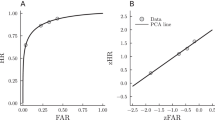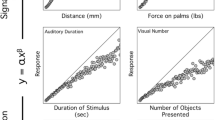Abstract
The optimal template for signal detection in white additive noise is the signal itself: the ideal observer matches each stimulus against this template and selects the stimulus associated with largest match. In the noisy ideal observer, internal noise is added to the decision variable returned by the template. While the ideal observer represents an unrealistic approximation to the human visual process, the noisy ideal observer may be applicable under certain experimental conditions. For template values constrained to lie within a specified range, theory predicts that the template associated with a noisy ideal observer should be a clipped image of the signal, a result which we demonstrate analytically using variational calculus. It is currently unknown whether the human process conforms to theory. We report a targeted analysis of the theoretical prediction for an experimental protocol that maximizes template-matching on the part of human participants. We find indicative evidence to support the theoretical expectation when internal noise is compared across participants, but not within each participant. Our results indicate that implicit knowledge about internal variability in different individuals is reflected by their detection templates; no implicit knowledge is retained for internal-noise fluctuations experienced by a given participant during data collection. The results also indicate that template encoding is constrained by the dynamic range of weight specification, rather than the range of output values transduced by the template-matching process.







Similar content being viewed by others
References
Abbey, C.K., & Eckstein, M.P. (2006). Classification images for detection, contrast discrimination, and identification tasks with a common ideal observer. Journal of Vision, 6, 335–355.
Ahumada, A., & Marken, R. (1971). Stimulus features in signal detection. Journal of the Acoustical Society of America, 49, 1751–1756.
Ahumada, A.J. (2002). Classification image weights and internal noise level estimation. Journal of Vision, 2, 121–131.
Awwad Shiekh Hasan, B., Joosten, E., & Neri, P. (2012). Estimation of internal noise using double passes: does it matter how the second pass is delivered? . Vision Research, 69, 1–9.
Bryson, A.E.J., & Ho, Y.C. (1975). Applied optimal control. Routledge.
Burak, Y., & Fiete, I.R. (2012). Fundamental limits on persistent activity in networks of noisy neurons. Proceedings of the National Academy of Sciences, 109(43), 17645–17650. https://doi.org/10.1073/pnas.1117386109. https://www.pnas.org/content/109/43/17645.
Burgess, A.E., & Colborne, B. (1988). Visual signal detection. IV. observer inconsistency. Journal of the Optical Society of America A, 5, 617–627.
Castillo, E., Luceño, A., & Pedregal, P. (2008). Composition functionals in calculus of variations. application to products and quotients. Mathematical Models & Methods in Applied Sciences 18. https://doi.org/10.1142/S0218202508002607.
Clifford, C.W., Webster, M.A., Stanley, G.B., Stocker, A.A., Kohn, A., Sharpee, T.O., & Schwartz, O. (2007). Visual adaptation: neural, psychological and computational aspects. Vision Research, 47 (25), 3125–3131.
Dosher, B., & Lu, Z.L. (2017). Visual perceptual learning and models. Annual Review Vision Science, 3, 343–363.
Faisal, A.A., Selen, L.P., & Wolpert, D.M. (2008). Noise in the nervous system. Nature Reviews Neuroscience, 9(4), 292–303.
Fleming, S.M., Dolan, R.J., & Frith, C.D. (2012). Metacognition: computation, biology and function. Philosophical Transaction of the Royal Society London B, Biological Sciences, 367(1594), 1280–1286.
Geisler, W.S. (1989). Ideal observer theory in psychophysics and physiology. Physica Scripta, 39, 153–160.
Geisler, W.S. (2011). Contributions of ideal observer theory to vision research. Vision Research, 51(7), 771–781.
Goris, R.L., Movshon, J.A., & Simoncelli, E.P. (2014). Partitioning neuronal variability. Nature Neuroscience, 17(6), 858–865.
Green, D.M. (1964). Consistency of auditory detection judgments. Psychological Review, 71, 392–407.
Green, D.M., & Swets, J.A. (1966). Signal detection theory and psychophysics, Wiley, New York.
Joosten, E.R., Shamma, S.A., Lorenzi, C., & Neri, P. (2016). Dynamic reweighting of auditory modulation filters. PLos Computational Biology, 12(7), e1005019.
Liberzon, D. (2012). Calculus of variations and optimal control theory. Princeton: Princeton University Press.
Lu, Z.L., & Dosher, B.A. (1998). External noise distinguishes attention mechanisms. Vision Research, 38, 1183–1198.
Malinowska, A.B., Sidi Ammi, M.R., & Torres, D.F.M. (2010). Composition functionals in fractional calculus of variations. Communications Fractional Calculus, 1, 32–40.
Mamassian, P. (2016). Visual confidence. Annual Review Vision Science, 2, 459–481.
Morvan, C., & Maloney, L.T. (2012). Human visual search does not maximize the post-saccadic probability of identifying targets. PLos Computational Biology, 8(2), e1002342.
Murray, R.F. (2011). Classification images: A review. Journal of Vision, 11(5), 1–25. https://doi.org/10.1167/11.5.2.
Murray, R.F., Bennett, P.J., & Sekuler, A.B. (2005). Classification images predict absolute efficiency. Journal of Vision, 5, 139–149.
Neri, P. (2009). Nonlinear characterization of a simple process in human vision. Journal of Vision, 9, 1–29.
Neri, P. (2010a). How inherently noisy is human sensory processing?. Psychonomic Bulletin & Review, 17, 802–808.
Neri, P. (2010b). Stochastic characterization of small-scale algorithms for human sensory processing. Chaos, 20, 045118.
Neri, P. (2010c). Visual detection under uncertainty operates via an early static, not late dynamic, non-linearity. Frontiers in Computational Neuroscience, 4, 151.
Neri, P. (2013). The statistical distribution of noisy transmission in human sensors. Journal of Neural Engineering, 10(1), 016014.
Neri, P. (2015). The elementary operations of human vision are not reducible to template matching. PLos Computational Biology, 11(11), e1004499.
Pelli, D.G. (1991). Noise in the visual system may be early. In Landy, M., & Movshon, A.J. (Eds.) Computational models of visual processing (pp. 147–152). Cambridge: MIT Press.
Pritchett, L.M., & Murray, R.F. (2015). Classification images reveal decision variables and strategies in forced choice tasks. Proceedings of the National Academy of Sciences of the United States of America, 112(23), 7321–7326.
Sagan, H. (1969). Introduction to the calculus of variations. New York: McGraw-Hill.
Sharpee, T.O., Miller, K.D., & Stryker, M.P. (2008). On the importance of static nonlinearity in estimating spatiotemporal neural filters with natural stimuli. Journal of Neurophysiology, 99, 2496–2509.
Solomon, J.A. (2002). Noise reveals visual mechanisms of detection and discrimination. Journal of Vision, 2, 105–120.
Sterling, P., & Laughlin, S. (2015). Principles of neural design. Cambridge MA: MIT Press.
Tjan, B.S., & Nandy, A.S. (2006). Classification images with uncertainty. Journal of Vision, 6, 387–413.
Tomic, I., & Bays, P.M. (2018). Internal but not external noise frees working memory resources. PLos Computational Biology, 14(10), e1006488.
Trifonov, M.I. (1994). New insight into internal noise in the psychophysical model for visual signal detection. SPIE, 2166, 32–43.
Vilidaite, G., & Baker, D.H. (2017). Individual differences in internal noise are consistent across two measurement techniques. Vision Research, 141, 30–39.
Xue, S. (1996). Optimization of template selection for signal detection systems with additive internal noise. Thesis, Rochester Institute of Technology.
Acknowledgments
This study was funded by Agence nationale de la recherche (grant numbers ANR-16-CE28-0016, ANR-19-CE28-0010-01 and ANR-17-EURE-0017).
Author information
Authors and Affiliations
Corresponding author
Ethics declarations
Conflict of interests
Author declares no conflict of interest.
Additional information
Action Editor: Destexhe and Victor
Publisher’s note
Springer Nature remains neutral with regard to jurisdictional claims in published maps and institutional affiliations.
Rights and permissions
About this article
Cite this article
Neri, P. Optimal templates for signal extraction by noisy ideal detectors and human observers. J Comput Neurosci 49, 1–20 (2021). https://doi.org/10.1007/s10827-020-00768-z
Received:
Revised:
Accepted:
Published:
Issue Date:
DOI: https://doi.org/10.1007/s10827-020-00768-z




